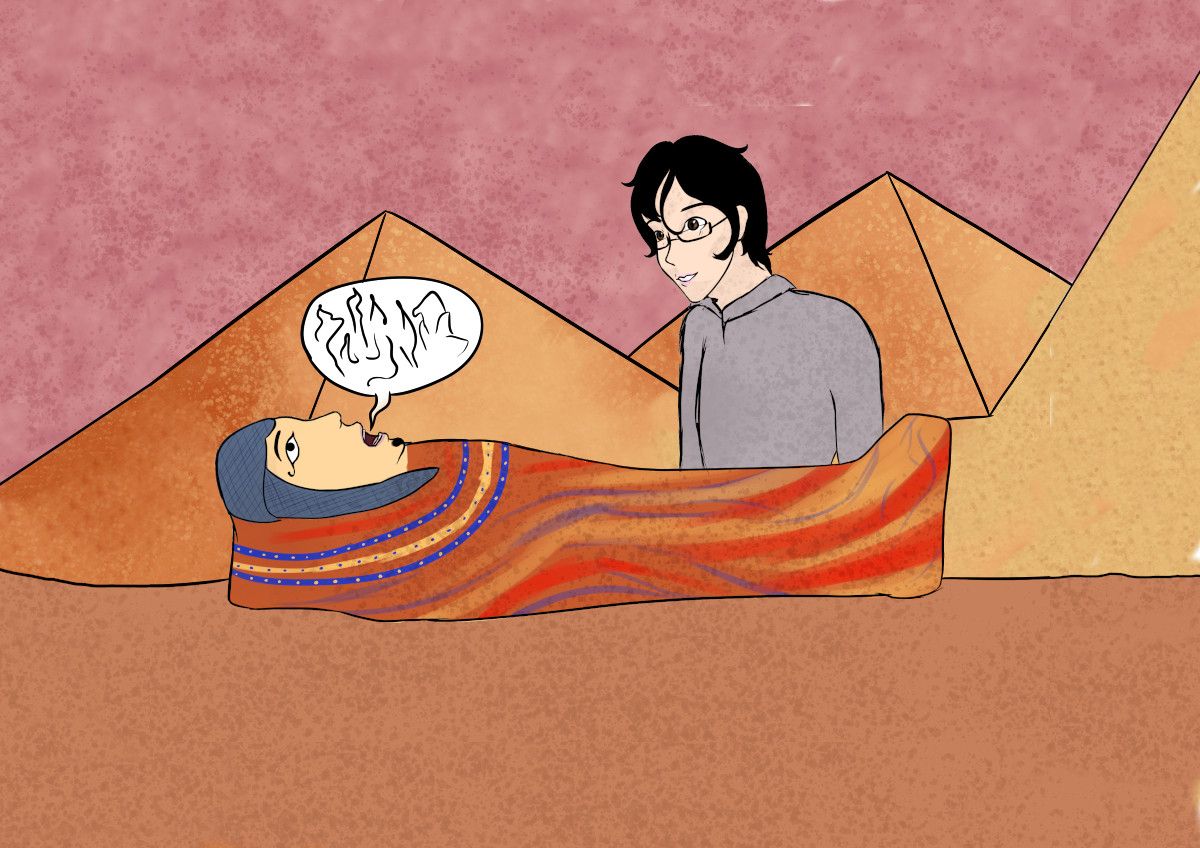A Mummy's Voice
How is modern science helping us reconnect with the past?

How is modern science helping us reconnect with the past?
Under the rule of the erstwhile Pharaoh Ramses XI, there lived a man called Nesyamun. He was a scribe and a priest, and he used his voice to perform rituals and sing songs to the Gods.
To get an idea of how passionate Nesyamun was about his work, you need look no further than his coffin’s inscriptions: among them is included a request that his soul might address the gods, as he had done for so long in his working life.
Times change, and Nesyamun’s world is long behind us. However, time also works in mysterious ways, and perhaps the story of this one priest is not yet over. But first, let us leave behind the ancient technology of mummification, and turn towards more recent human inventions.
A few days before the Christmas of 1895, Anna Röntgen went into her husband’s lab to have a photograph taken of her hand with his new invention. But the photograph was no ordinary one. Instead of her hand as she knew it, what Anna saw was a skeletal hand—carpals, phalanxes, and all—wearing the ring that was on her finger. “I have seen my death!” she exclaimed.
What Anna’s husband had discovered was not death, but a new kind of radiation that could pass through black cardboard, blocks of wood, and, evidently, skin and flesh. For the sake of brevity, Wilhelm Röntgen—husband of Anna, future Nobel laureate—decided to call “X-rays”.
Wilhelm was a physicist, but his invention caused a revolution in medicine. Suddenly, doctors could see right inside their patients and diagnose what was wrong without having to rely on feel, or, horror of horrors, cutting them open to investigate. This is possible because of X-rays’ special wavelength. Unlike visible light, X-rays are situated in a range that is not absorbed much by the atoms of our body. That means they can easily pass through, only leaving a “shadow” of the bones we want to see.
Traditional X-rays are two-dimensional, but these days we have a 3D version: computerised tomography or CT scans.
In this method, the patient stays still while X-rays are sent through their body at different angles and various locations. Whatever X-rays aren’t absorbed are collected at the other end of the body, and their new intensities are compared with the original.
You can think of the space the body occupies as being composed of many cubes or ‘voxels’—think pixels, but in 3D. By looking at the X-ray pattern, one can compute which voxels are filled, which aren’t. More helpfully, because the X-rays are sent in from all directions, one can even identify how dense each voxel is.
This density is key, because computing the density of all these voxels allows us to reconstruct images of cross-sections of the body — including bones, blood vessels, soft tissues, and wedding rings.
Of course, the reason these things are visible is because they block X-rays and cast a shadow of sorts. The power of the X-ray lies not just in what it can pass through, but also in what it can’t.
The years from 1961 to 1972 are often called the golden age of airline hijacking. More than a hundred US aircraft were hijacked in that time, often within weeks of each other. Many hijackers demanded that the pilots fly them to Cuba, which was a vocal opponent of the US and would protect any hijackers from retribution. When Cuba cheekily offered to return the hijacked planes for only $7500, it was clear that something had to be done.
The solution? X-ray machines.
As Anna Röntgen’s eerie photograph can attest to, bones aren’t the only things that show up on X-ray. Rings do too, as do various other types of metal. All security officials had to do was pass people through an X-ray machine, and, if they were carrying any weapons or other suspicious instruments, they’d show up in the scan—even if they were hidden or buried.
The idea initially faced opposition, for fear it would scare the passengers and constitute an invasion of privacy. But other options, such as psychological profiling, proved ineffective. Things went from bad to worse: planes started carrying route maps to Cuba to make their final journeys smoother; a plan to build a fake Cuban airport in Florida was shelved.
Finally, the administration gave in, and the age of annoying security and baggage checks had officially begun.
Airline hijackings are scary and dangerous, no doubt—but not more so than the uses planes were put to earlier. Before commercial flights, there were warplanes; planes sent out specially to cause death and destruction. The Second World War was one frenzied example of that, and, incidentally, one that pulled in our priest Nesyamun too.
In 1824, three mummified priests were gifted to the Leeds Philosophical and Literary Society, under whose care they stayed for over a century. Sadly, this care came to an end during the Leeds Blitz Bombing of 1941, when Nazi German aeroplanes conducted a raid on Leeds City. The bombing destroyed a lot of precious artefacts, including two of the three mummified priests from the museum.
There was only one priest who survived the attack: Nesyamun.
An individual, said the Ancient Egyptians, is composed of three main entities: their physical body, their divine vital force, ka, and their personality and soul, ba. When a person dies, their ka leaves them, but their ba travels to the underworld in the hope of being reunited with the ka.
The catch: this reuniting happens only after the ba has passed divine judgement.
We now believe this is why the people of Ancient Egypt preserved the bodies of the dead. The process of mummification was to allow the ba to navigate afterlife and to reunite with the ka. And this preservation applied not just to humans, but often to other animals too.
Animal mummification could be for various reasons: the animals in question might have been pets; they may have been offered as food for human mummies in the afterlife, or as food for Gods; the animals could have been sacred and therefore deemed to be treated like a human.
Whatever the reasons, mummified humans and animals have left modern man with enormous information about the way of life during those times. We don’t know how these individuals were judged in their afterlives, but we, their distantly future ancestors, are judging them again today.
In 2020, six researchers got together to study several mummified animals: a cat, a bird, and a snake. To look inside these creatures, they used micro-CT: the same technology that is used to make CT scans in hospitals, but using smaller voxels for a smaller body. This makes for a higher resolution, and also limits the volume studied—perfect for specimens of small size.
By analysing the scans, researchers could figure out a lot more about what happened to the animals when they were alive. The snake, it turned out, was always kept in poor condition, until it eventually dehydrated to death. By looking at the cat’s teeth, they saw that it was less than five months old when it had its neck broken. As for the bird, its history was less clear, but it was identified as some kind of falcon with a broken wing.
While small stories on their own, studying animal mummies can reveal more about the human-animal interaction in ancient Egypt—and it can do so without opening up the mummies and risking damage.
Before the animal studies, though, another group of researchers had tried something even more ambitious: resurrecting the voice of a long-dead priest.
On the eve of the COVID-19 pandemic, a different set of six researchers got together to break Nesyamun’s long silence.
Voice is produced by the larynx or ‘voice box’, and is our very own musical instrument. The precise structure of an individual’s voice box produces a sound unique to them—as unique, in fact, as a fingerprint.
Fortunately, the soft tissue of Nesyamun’s throat was not greatly damaged. By performing CT scans of the priest’s larynx and throat, they were able to get a digital snapshot of its structure. And then comes the high-tech part: this structure was fed to a 3D printer, to reconstruct a replica of his vocal tract! Along with an electronic larynx source, this helped them produce sounds the way he would have made them.
Although the phonetics and timing patterns of his language are not known today, we can still listen to what the voice might have sounded like using this procedure. The ancient technology of mummification has collaborated with the modern ones of X-ray scanning and 3D printing, and, in the process, brought the dead priest one step closer to making his wish come true.
Nesyamun may yet speak again.
